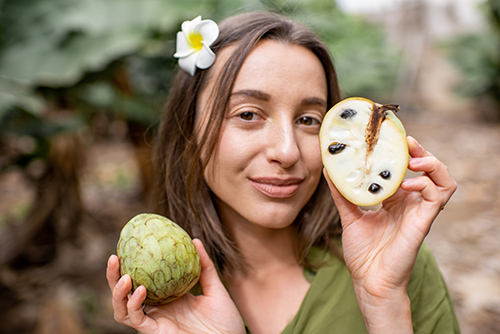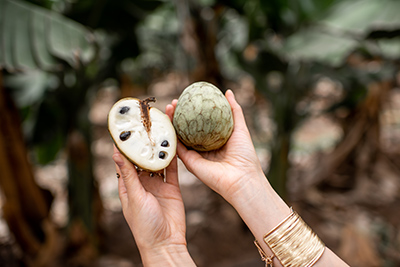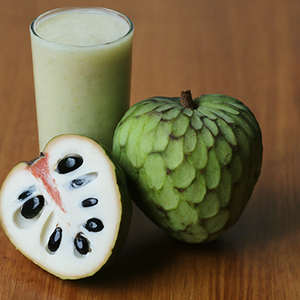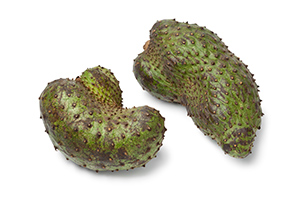Contents
Cherimoya health benefits: Describing the taste of cherimoya is not easy, especially for someone that had never tasted it. Some say it reminds them of strawberries, while others say it reminds them of eating a pineapple, pear, or banana. But one thing is sure: the creamy white pulp of the cherimoya has a unique flavor that conjures the pleasant aromas of the tropics.
The cherimoya is a tropical fruit typical of the Andean region. Its name is taken from the Quechua word chirimuya. Although it grows at high elevations, natives of the Andean Altiplano say that although the cherimoya cannot tolerate snow, it likes to see it in the mountains.
Perhaps because of this, the cherimoya has adapted well to the warm valleys near the Sierra Nevada in Granada, southern Spain. Most of Europe’s cherimoya production is concentrated in these uniquely beautiful subtropical Andalusian landscapes, while in the distance are the snow-covered peaks of the Sierra.

Cherimoya Scientific Facts
- Scientific name: Annona cherimola Mill.
- Other names: Custard apple, Anona, Sherbert-fruit.
- French: Chérimole.
- Spanish: Chirimoya, Anona chirimoya.
- German: Cherimoya.
- Description: The cherimoya is the fruit of the Cherimoya tree, a tree of the botanical family Annonaceae that reaches a height of 8 meters. The fruit is heart-shaped and weighs 100 grams to over a kilo. It is covered with a green rind with a scale-like design reminiscent of a reptile. The pulp contains numerous black seeds that are easily removed.
- Environment: The cherimoya grows wild in the Andean Altiplano regions of Ecuador and Peru at 1,000 and 2,000 meters. Today, it is raised all over Central America, Southeast Asia, and Mediterranean countries.
Cherimoya Health Benefits
Cherimoya is famous for its sugar content. Among the sugars, fructose and saccharose are prominent. However, its fat and protein content is superficial. Among the vitamins in the Cherimoya, those in the B group are the most notable: B1, pyridoxine, and niacin. Cherimoya provides between six and ten percent of the daily need for each vitamin.

This means that only one medium-sized cherimoya provides between one-third and one-half of the recommended daily allowance of these B-group vitamins. No other fresh fruit of equal weight provides as many B-group vitamins as the cherimoya.
Cherimoya’s richness in calcium, phosphorus, iron, and potassium is noteworthy where minerals are concerned. Only oranges, loquats, dates, and raspberries have more calcium. The energy content of ninety-four calories per one hundred grams is considerable, bearing in mind that this is fresh fruit.
The cherimoya health benefits are recommended for all ages, particularly for adolescents. Athletes and students will also gain energy with the vitamins and minerals appropriate for their activities. The diet therapeutic applications of the cherimoya are:

During this time, cherimoyas should not be refrigerated since this slows the ripening process and reduces flavor. They should be ripened in a place protected from light to keep their skin from turning black.
Heart failure – the cherimoya health benefits provide a significant amount of energy in the form of sugars and B group vitamins that the body requires to benefit from this energy. The B vitamins in the cherimoya behave as catalysts or initiators of the combustion of carbohydrates and fatty acids, representing the two most important energy sources for the heart’s cells.
The most common causes of heart failure are lesions in the heart valves, arterial hypertension, or narrowing of the coronary arteries. A lack of B-group vitamins can also cause a heart attack. Consuming a cherimoya once a day during the autumn and winter months benefits all who suffer from tired hearts for whatever reason.
Furthermore, cherimoyas demonstrate these benefits: They are diuretics, contain vegetable fiber, are very low in sodium and fat, and are rich in potassium, meeting the requirements of a heart-healthy food. As if this were not enough, cherimoyas contain a certain amount of calcium, a necessary mineral to regulate the heartbeat.
Stomach ailments—Cherimoya’s creamy, smooth pulp, with its antacid effect, is helpful to the stomach. It is highly advised in cases of gastritis and gastroduodenal ulcers.
Obesity—Despite their relatively high carbohydrate content, cherimoya health benefits are practical in weight-loss treatments. This is because of their satiating effect. A 300-gram cherimoya provides less than 300 calories but is as filling and satisfying as a plate of food or a sandwich, which may contain more calories and be higher in fat.
Because of its high nutrient content, cherimoya is naturally refreshing and satisfies the appetite. This allows a reduction in calories without an accompanying feeling of faintness.
How to use Cherimoya

It is possible to know when a cherimoya is ripe just by feeling it yield slightly to the touch. All annonas combine well with orange or lime. Beverages based on annona pulp blended with orange or lime juice are refreshing and delicious. They are a healthful and delightful beverage for those suffering from heart disorders.
- Fresh – This is how cherimoyas are commonly eaten. In this manner, one enjoys their exquisite flavor and benefits from their therapeutic properties to the fullest extent.
- Shakes – Cherimoyas combine very well with orange juice or milk. The pulp must be appropriately strained to remove the seeds and create a puree.
- Remove the stem by pulling gently. These are easily removed from ripe fruit.
- Cut it in half with a knife.
- You can remove the pulp with a spoon, eat it just as it is, or strain it into a puree.
- Strain the pulp to prepare a puree for beverages, frozen desserts, or shakes.
The Annonaceae Family
The genus “Annona,” with more than 120 species, is the most important of this family of Central American tropical fruits. About 20 of these 120 species are cultivated for their fruit, but only four are of dietary importance. “annon” or “annona” are commonly used to refer to any fruit in this family. The composition and properties of these fruits are very similar to those of the cherimoya. Variations among them are primarily in shape and flavor.

- Cherimoya (Annona Cherimola Mill.) is the most economically essential annona, and its medicinal effects are the most proven. This article analyzes it because of this. The smooth, creamy pulp has helped cherimoya conquer markets and palates worldwide.
- Soursop (Annona muricata L.) is the largest annona, reaching up to two kilos. It is kidney-shaped and covered with soft spines. Its pulp tends to be quite tart and is not usually eaten fresh but in juices, frozen desserts, and preserves. Soursop is astringent, cholagogic, and promotes digestion. It is recommended in cases of constipation, obesity, hypertension, coronary disease, and diabetes.
- Sugar apple (Annona squamosa L.)—This fruit is grown primarily in the Far East. It is heart-shaped and has very pronounced scales on its rind. The pulp is creamy like the cherimoya but slightly sweeter and has a flavor reminiscent of cinnamon. Sugar apples are used in desserts, ice cream, and beverages.
- The custard apple (Annona reticulata L.) is a heart-shaped apple Grown primarily in India and Southeast Asia. The rind is scaly, first green and then dark red. The pulp is used in beverages and desserts.
DISCLAIMER: All content on this website is presented solely for educational and informational objectives. Do not rely on the information provided as a replacement for advice, diagnosis, or treatment from a qualified medical expert. If you are pregnant, nursing, or have any preexisting medical concerns, talk to your doctor before using any herbal or natural medicines.
REFERENCES
George D. Pamplona-Roger, M.D. “Encyclopedia of Foods and Their Healing Power.” George D. Pamplona-Roger, M.D. Encyclopedia of Foods and Their Healing Power. Trans. Annette Melgosa. Vol. 2. Chai Wan: Editorial Safeliz, 2005. 59, 60, 61, 62. Print. [cherimoya health benefits]
